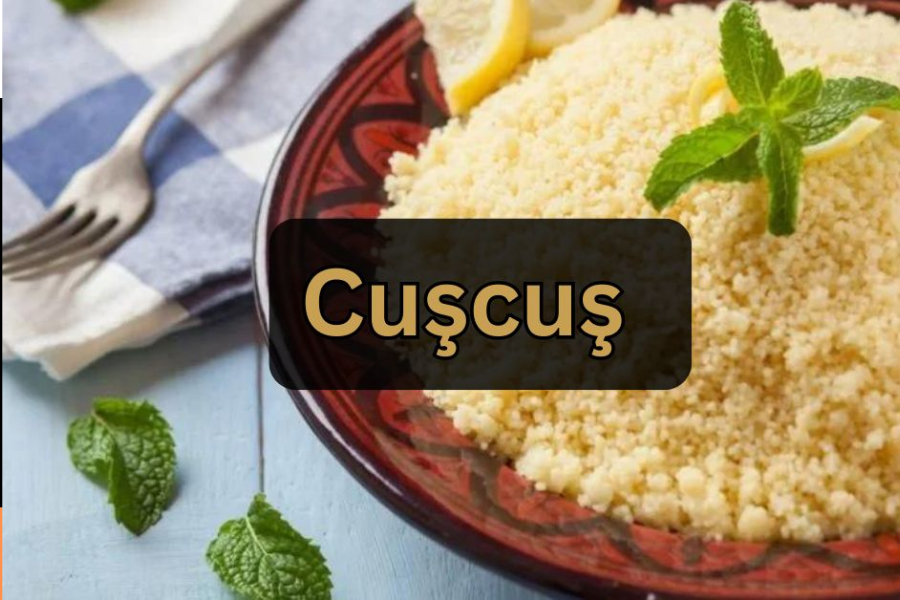Discovering the Culinary Delight of Cuşcuş: From North Africa to Your Kitchen
In the vast landscape of global cuisine, few dishes have traveled as far and wide as Cuşcuş. Originating in North Africa, this beloved dish has not only withstood the test of time but has also found its way into kitchens around the world, captivating the taste buds of food enthusiasts everywhere. Whether you’re a seasoned chef or someone just beginning to explore international flavors, Cuşcuş offers a unique culinary experience that combines rich history, cultural significance, and delightful versatility.
In this article, we’ll take a closer look at the fascinating journey of Cuşcuş, exploring its origins, cultural importance, and the various ways it has evolved. We’ll also share tips and tricks for incorporating Cuşcuş into your own kitchen, allowing you to enjoy this extraordinary dish with ease and creativity.
The Journey of Cuşcuş: From Humble Beginnings to Global Fame
Cuşcuş, a dish that has become synonymous with North African cuisine, traces its roots back to the Berber people, who have inhabited the region for thousands of years. The history of Cuşcuş is believed to stretch as far back as the 11th to 13th centuries, when it first began to appear in the Maghreb region, encompassing modern-day Algeria, Morocco, and Tunisia. The name “Cuşcuş” is thought to derive from the Berber word “seksu,” which means “well-rolled” or “rounded,” a reference to the traditional method of preparing the dish.
Originally, Cuşcuş was a simple, everyday food for the Berbers, made from semolina wheat that was rolled into small grains, steamed, and served with a variety of stews. Its simplicity and versatility quickly made it a staple in North African households, and as time passed, Cuşcuş began to spread beyond the Maghreb. The dish was introduced to Europe by the Moors, where it gained popularity and was adapted to suit local tastes and ingredients.
Today, Cuşcuş is enjoyed in kitchens worldwide, from Europe and the Middle East to the Americas and beyond. Its adaptability and endless possibilities for culinary creativity have allowed it to evolve while still maintaining its core identity as a nourishing and comforting dish.
Cuşcuş in Culture: More Than Just a Meal
In North African culture, Cuşcuş is more than just a dish—it’s a symbol of togetherness, celebration, and hospitality. It plays a central role in various cultural and religious ceremonies, often being prepared for special occasions such as weddings, religious holidays, and family gatherings. The process of making Cuşcuş is often a communal activity, where family members come together to prepare the dish, reinforcing social bonds and fostering a sense of community.
Cuşcuş is also associated with hospitality and generosity. Serving Cuşcuş to guests is considered a gesture of goodwill, symbolizing abundance and prosperity. In many North African households, offering Cuşcuş is not just about feeding the body; it’s about nourishing the soul and creating connections with others. This cultural significance has helped Cuşcuş endure through the centuries, making it a cherished part of both everyday life and special occasions.
Ingredients and Simple Preparation Techniques
At its core, Cuşcuş is made from semolina wheat, which is mixed with water to form small grains. These grains are then steamed over a pot of simmering stew, allowing them to absorb the rich flavors of the dish. While traditional Cuşcuş is made with semolina, there are numerous variations that use different grains, such as pearl millet, barley, or cornmeal. These variations cater to different tastes and dietary needs, making Cuşcuş a versatile dish that can be enjoyed by a wide range of people.
The beauty of Cuşcuş lies in its simplicity and versatility. It can be paired with a variety of ingredients, including vegetables, meats, and fish, allowing you to tailor the dish to your preferences. For those looking for a unique twist, there are even sweet versions of Cuşcuş that incorporate dried fruits, nuts, and spices for a delightful dessert.
Preparing Cuşcuş is relatively straightforward, but there are a few key tips to keep in mind for the best results. First, use a large, shallow bowl to spread the grains evenly. This ensures even cooking and prevents clumping. When steaming, be careful not to overcook the grains—they should remain light and fluffy. A touch of olive oil and a pinch of salt can enhance the flavor, but don’t be afraid to experiment with different spices and herbs to suit your taste.
Regional Varieties of Cuşcuş: A World of Flavors
One of the most fascinating aspects of Cuşcuş is its ability to adapt to different culinary traditions, resulting in a variety of regional variations. In Morocco, Cuşcuş is often served with a vibrant seven-vegetable stew, which might include ingredients like carrots, zucchini, and chickpeas. The dish is typically flavored with a blend of spices, such as cumin, coriander, and turmeric, giving it a warm and aromatic profile.
In Algeria, Cuşcuş is frequently paired with lamb or chicken and spiced with saffron and cinnamon. The use of saffron adds a luxurious depth of flavor, while the cinnamon brings a subtle sweetness to the dish. This combination of flavors creates a rich and satisfying meal that is both comforting and indulgent.
Tunisian Cuşcuş, on the other hand, is known for its bold, spicy flavors. It is often enhanced with harissa, a fiery chili paste that adds a distinctive kick to the dish. Tunisian Cuşcuş might also include ingredients like tomatoes, peppers, and olives, which contribute to its vibrant and robust character.
These regional differences highlight the versatility of Cuşcuş, showing how it can be adapted to suit various tastes and culinary traditions. Whether you prefer the subtle flavors of Moroccan Cuşcuş, the rich and spiced Algerian version, or the bold and spicy Tunisian take, there’s a version of Cuşcuş to suit every palate.
Nutritional Benefits of Cuşcuş: A Healthy Choice
Cuşcuş isn’t just delicious—it’s also packed with nutrients, making it a healthy choice for any meal. As a great source of carbohydrates, Cuşcuş provides the energy needed to keep you going throughout the day. It’s also high in fiber, which aids in digestion and helps you feel full longer, making it a smart choice for those looking to manage their weight.
In addition to being a good source of energy and fiber, Cuşcuş is rich in essential vitamins and minerals. It contains selenium, an antioxidant that plays a key role in maintaining a healthy immune system, as well as magnesium, which is important for muscle and nerve function. Cuşcuş also provides B vitamins, which help convert food into energy and support overall health and well-being.
Incorporating Cuşcuş into your diet is an easy way to enjoy a nutritious and satisfying meal. Whether you’re looking to boost your energy levels, support your digestive health, or simply enjoy a delicious dish, Cuşcuş is a versatile and healthy option that can be enjoyed by everyone.
Cuşcuş in Today’s Kitchens: A Modern Twist on a Classic Dish
In today’s culinary landscape, Cuşcuş has become a favorite ingredient for both home cooks and professional chefs. Its ability to absorb flavors makes it an ideal base for a variety of dishes, from hearty salads to elegant main courses. Whether you’re preparing a casual family meal or hosting a sophisticated dinner party, Cuşcuş is a versatile choice that can elevate any occasion.
Modern chefs often experiment with Cuşcuş, blending traditional methods with new and exciting flavors. For example, you might find Cuşcuş paired with Asian-inspired ingredients like soy-glazed tofu and stir-fried vegetables, or incorporated into a Mediterranean dish with grilled vegetables and feta cheese. The possibilities are endless, making Cuşcuş a fun and versatile addition to any meal.
For those looking to get creative in the kitchen, consider hosting a Cuşcuş-themed dinner party. Set the mood with colorful decor inspired by North African culture, and offer a variety of Cuşcuş dishes that showcase different flavors and ingredients. Complement the meal with traditional beverages like mint tea or Moroccan wine to create a truly immersive experience.
Tips for Perfect Cuşcuş Every Time
Achieving the perfect Cuşcuş takes a bit of practice, but the results are well worth the effort. Here are some tips to help you master this delicious dish:
- Use a Large, Shallow Bowl: When preparing Cuşcuş, use a large, shallow bowl to spread the grains evenly. This ensures even cooking and prevents clumping.
- Don’t Overcook: Be careful not to overcook the Cuşcuş grains. They should remain light and fluffy, with a tender texture.
- Enhance the Flavor: A touch of olive oil and a pinch of salt can enhance the natural flavor of Cuşcuş. Don’t be afraid to experiment with different spices and herbs to suit your taste.
- Steam for Best Results: Steaming Cuşcuş allows the grains to absorb the rich flavors of the stew below, resulting in a more flavorful dish.
- Get Creative with Pairings: Cuşcuş is incredibly adaptable and can be paired with a wide variety of ingredients. Whether you prefer a savory or sweet dish, there’s a pairing that’s perfect for you.
Pairing Cuşcuş with Global Flavors
One of the reasons Cuşcuş has become so popular around the world is its adaptability to different culinary traditions. In Mediterranean cuisine, Cuşcuş is often served with grilled vegetables and feta cheese, creating a light and refreshing dish that’s





